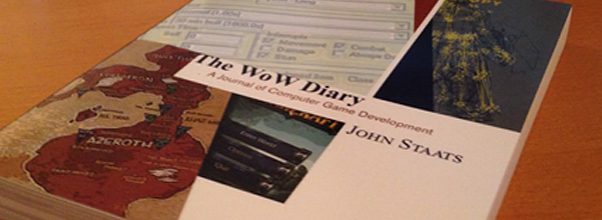There are few good books about the inner workings of the
There are even fewer exceptional books such as Raph Koster’s A Theory of Fun of Game Design. I can say without reservation that John Staat’s WoW Diary: a Journal of Computer Game Development is an exceptional book where readers are treated to a rare, behind the scenes, deep in the trenches chronicle of the making of perhaps the greatest video game ever made: World of Warcraft.
Not only is the WoW Diary an impressive first-hand account of how WoW was made, but it is also an unparalleled treasure trove of thoughtful insights that reveal the secret sauce of the Blizzard’s legendary creative magic as the book is lavishly punctuated with mini-essays where the author goes into great detail about the design philosophy of WoW — how it came about and how it evolved along the way.
The author John Staats was one of the first 3D modelers hired by Blizzard to work on Blizzard’s Team 2. In
Although the WoW Diary is all from his perspective, you’ll get to meet many of his teammates along the way through archived conversations John dutifully wrote down in his diary. You’ll get to experience their triumphs and their failures. You’ll also get to feel what it must have been like to work at Blizzard, back when they were a lean and hungry boutique studio in a non-descript Irvine business park.
Included in the WoW Diary are a goldmine of non-released screenshots and photos of proprietary tools used in the making of WoW. While this is not an official Blizzard book, nonetheless John got their backing and support to help make the book as they gave him permission to use many of the images contained within. The WoW Diary is an impressive chronicle of a 4-year up and
As time passed and the success of WoW great to meteoric heights, Blizzard has been reluctant to share details about how their MMO was really made and the result was that we’d often get a sanitized series of PowerPoint presentations from their senior designers with slogans like “easy to learn, hard to master” and “when it’s ready.” Over the years Blizzard started to create their own mythology about themselves and their King Midas-like success and would only reveal corporate approved tidbits of useful info.
What becomes clear after reading this book is that part of WoW’s success was based on the luxury and freedom of being able to capitalize on lessons learned by trial and error and constant iteration that allowed them to polish the game as they made it. Because back then — before the days of their merger with Activision and having shareholders breathing down their necks — Blizzard was their own publisher, they were not enslaved to the dictates of publishers who want a video game to come out at a particular time such as Christmas.
One example of this is that WoW was never meant to be quest-centric and narrative based. Initially, quests were only to help direct players of the appropriate level to new zones. Soon the testers became dependent on quests and Blizzard decided to put them in every zone which completely transformed the MMORPG which originally was supposed to be a level up experience grind like EverQuest.
What struck me the most about this book was the tremendous dedication and self-sacrifice that John and his fellow teammates put into the project. John would work weekends on his own time, creating and perfecting all of the micro dungeons in WoW as a matter of personal pride. It was not uncommon for him to work 90 hours a week and he admits that he never once managed to wrestle himself away from his computer screen to visit the beautiful ocean beaches of Orange County in California.
What shocked me was how much crunch time (mandatory overtime) Blizzard employees were expected to work during the 6 years it took to create WoW. Back then, before California modernized it’s labor laws, crunch time was (and probably still is) a necessary evil in the video game industry because developers are beholden to schedules (milestones) set by publishers. Since Blizzard is their own publisher, they would not have to worry about meeting arbitrary deadlines but after reading John’s book you realize that Blizzard set their own milestones. Most were to meet the self-imposed milestones and schedules of important tradeshows such as E3.
Scattered throughout John’s diary are impressive nuggets of video game industry wisdom which he’s gleaned along the way. As you start to read the WoW Diary it comes very clear that John is a very talented writer and profound thinker. Here are just a few previews from his Twitter account:
One of the more interesting nuggets in the book is how Team 2 vigorously debated the notion of instanced dungeons versus public dungeons as was the norm in EverQuest. As instanced dungeons devalued the social aspect of MMOs and eroded the sense of believability with multiple Onyxias being killed at any given time, they offered a pristine dungeon crawl experience free from the problem of players camping spawns. Instanced
Another interesting part of the book reveals the influence of Allen Adham and Jeff Pardo on the design of WoW. After reading John’s diary it becomes clear that both of them were really the ones responsible for making WoW so friendly to casual gamers by allowing them to solo to the level cap with ease. Combine this with WoW’s quest-centric directed gameplay and for all intents and purposes, WoW became the first single-player MMORPG with dungeons and some raids thrown in for good measure.
I suppose Blizzard thought that traditional MMO players would gravitate to playing in instanced dungeons and eventually doing raiding content. Casual players having fun with easy solo content might be tempted to join groups and even guilds to participate in raiding to get an epic piece of gear. Raiders who got burned out or who had less time could return to grouping or solo content. Blizzard designed WoW like a freeway: the slow lane for
Work on WoW began in the summer of 1999 just a few months after the release of EverQuest as per a map included in the book which outlines Azeroth and most or what we know as WoW when it went live in 2004. EverQuest was all the rage back then and the possibilities of virtual worlds seemed endless.
I’m not sure if WoW ever had a design document. From what I have gleaned in John’s book, the plan was to make a Warcraft version of EverQuest but with more refinement and less cumbersome gameplay.
John describes a company that valued collaboration where everyone felt they could offer opinions. This was possible because back then, Blizzard was still a very small studio and the scourge of bureaucratic rot and office politics had not yet taken over. In a sense, everyone at Blizzard was simultaneously a game designer and a gamer with an all hand on deck attitude that gave the company free and instant feedback.
The phrase “looking for fun” comes up a lot in the book. While this is an admirable approach, I think some of the “fun” things while providing instant gratification turned out to have disastrous unintended consequences over the years.
Basing everything solely on fun is like eating food just because it tastes good and not for its nutritional value. Ten years of eating only devouring Big Macs, pizza, and milkshakes
In the years that followed and to this day, the social element of WoW is practically non-existent and many people are downright anti-social and annoyed if anyone dares speak in a group. Adventuring with fellow players
With all their talent, resources and tech, why did Blizzard manage to find the fun with WoW but not with Titan? What at Blizzard had changed? In a way, the underlying premise of the WoW Diary “finding the fun” as an ingredient of the secret sauce for WoW becomes somewhat suspect because of Blizzard’s shocking inability to create another successful MMO despite having every advantage at
There is no doubt that making MMOs is impossibly hard and a labor of love but I think what Blizzard achieved with WoW is also attributable to being at the right place at the right time, having EverQuest to steal all your ideas from and innovate on, and yes, a lot of luck.
John goes into the reasons for Blizzard’s reticence to talk about their games to the public in between tradeshows. All these years, I can’t help but think that Blizzard’s cult of secrecy has been a double-edged sword. Of course, it helped them to focus on their work but too often it isolated them from important feedback from fans and critics. This vacuum of information created speculation that made Blizzard seem arrogant and dismissive. The WoW Diary respectfully removes the cloak of secrecy and gives the reader insight into how and why many decisions came to be.
The WoW Diary chronicles an important era of video game history: the rise of the massively multiplayer online role-playing game. I believe this is one of the most important books ever written about the video game industry. In the future, I hope that other Blizzard employees such as Rob Pardo will also take the plunge and write about their experiences with the company.
John Staat’s WoW Diary is a towering achievement that whisks you away on an epic journey that takes you through dimly lit cubicles and pizza-fueled crunch times — all from an idea in Chris Metzen’s head to a full-blown living and breathing virtual world. This book is a must read for anyone seriously contemplating a career in the video game industry and anyone interested in creating MMO’s and virtual worlds. John Staats account of what it was like to work at Blizzard is very honest and sobering. This book gave me a deeper appreciation for the sacrifices made by Blizzard employees and their masterpiece that is WoW. I highly recommend this book!
-Wolfshead





“what it must have been like to work at Blizzard, back when they were a lean and hungry boutique studio” Yes, that lean and hungry boutique studio who only produced multiple titles which were the best selling or among the best selling titles for the years they released in, oh the shame of having only six games in the last decade be huge hits! Did you have no familiarity with Blizzard prior to WoW and not bother researching them?
What’s wrong with being a lean and hungry boutique studio? Blizzard was a small boutique studio before WoW. That’s just the truth. That comment actually was inspired by former Blizzard WoW Team Lead Mark Kern who said almost word for word the very same thing in a 2018 video interview with Jeremy Hambling of The Quartering. That comment was not meant to disparage Blizzard at all.
The video interview is no longer available on YouTube but here’s a thread on Reddit talking about Kern’s revelations:
https://www.reddit.com/r/Blizzard/comments/9z1y57/mark_kern_lead_developer_on_wow_tells_the_story/
You seem to be looking for a way to fault me but all you’ve done is created an obvious straw man. It didn’t work. If you want to continue to post on this site, do so in good faith. Thank you.